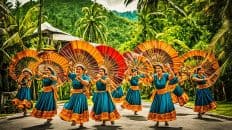Ever wondered about the breathtaking landmarks of Bohol in the Philippines? This province boasts a deep historical background. It has fascinated travelers for ages. Let’s dive into the rich history of Bohol. We’ll uncover the ancient origins and the major events that created its culture. Get ready to explore the secrets behind its famous landmarks.
Bohol’s past goes way back to the Iron Age, showing signs of early settlers. It grew into a cultural melting pot. This was thanks to indigenous tribes, traders, and colonizers. They all left their mark here.
The story of Bohol flows from Spanish rule to today. It’s filled with conquests, resilience, and cultural exchanges. Its historical sites and architectural wonders tell tales of its intriguing past.
So, pack your bags for an adventure to uncover Bohol’s hidden treasures. We’ll unlock the mysteries of its rich past together.
Key Takeaways:
- Bohol’s history goes back to ancient times, highlighting its vast cultural heritage.
- Spanish colonization had a big impact, leaving behind famous landmarks and churches.
- Bohol houses landmarks like Baclayon Church and Loboc Church, among others. These sites offer a peek into its history.
- These landmarks show different architecture and events that define Bohol.
- Despite natural disasters, restoration has preserved these sites. They let visitors see Bohol’s cultural heritage up close.
Baclayon Church: A Neoclassical Marvel
Located in Baclayon, Bohol, the Baclayon Church is a symbol of history. It was founded in 1596 by Jesuit priests and is officially named the Immaculate Conception of the Virgin Mary Parish Church. This church is an important piece of Bohol’s rich past.
The church was built mainly from coral stones. It beautifully combines neoclassical style with religious symbols. Visitors are drawn to its baroque pulpit and the detailed ceiling murals. These aspects show the artistic and architectural greatness of earlier times.
“Baclayon Church is more than just a building; it represents our shared history and cultural identity. Its fixing after the earthquake shows how important it is to keep our heritage alive for the young ones.”
– Local historian, Maria Santos
In 2013, an earthquake badly damaged the church. But, thanks to hard work, it has been restored to its original beauty. The restoration work took care to keep its historical and cultural value. Now, everyone can see how magnificent the Baclayon Church truly is.
If you’re visiting Bohol, think about staying at Henann Resort Alona Beach. It’s a luxury resort close to the church. This beautiful place offers a peaceful setting and is a great spot to explore Baclayon Church and Bohol’s other historical sites.
| Key Features of Baclayon Church |
|---|
| Neoclassical architecture |
| Baroque pulpit |
| Intricate ceiling murals |
| Restored after the 2013 earthquake |
Loboc Church: The Jesuits’ Legacy
Loboc Church, also known as the San Pedro Apostol Church, is a key part of Bohol’s culture. Finished in 1734, it highlights the Jesuits’ influence in architecture. This church, with its Baroque design, was central to the Jesuits’ mission.
“Loboc Church is a testament to the rich history of the Jesuits in Bohol. Its grandeur and intricate details showcase the Spanish colonial architecture at its finest.”
In 2013, an earthquake damaged Loboc Church. But it has been beautifully rebuilt, showing Bohol’s commitment to its heritage. This work underlines the effort to keep Bohol’s history alive.
Bohol Tropics Resort offers a cozy stay near Loboc Church. It’s a great place to take in Loboc Church’s beauty and learn about Bohol’s interesting past.
Key Features of Loboc Church:
- Baroque architectural style
- Damaged in the 2013 earthquake
- Remarkable reconstruction efforts
- National Cultural Treasure
- Bohol Tropics Resort nearby
Plan Your Visit to Loboc Church:
| Location | Opening Hours | Admission Fee |
|---|---|---|
| Loboc, Bohol | 8:00 AM – 5:00 PM | Free |
Dauis Church: A Blend of History and Artistry
Dauis Church, also known as the Church of Our Lady of the Assumption, is on Panglao Island. It was built in 1863. The church is a beautiful example of Gothic architecture with neoclassical insides.
It has a deep history besides its stunning looks. In World War II, nuns used it as a safe place. This adds to its meaning as a symbol of hope and strength in hard times.
The church was damaged in the 2013 earthquake but has been beautifully restored. This shows the community’s effort to keep their history and architecture alive. The church now stands as a sign of the people’s strong spirit and their love for their heritage.
Discover the exquisite blend of history and artistry at Dauis Church, where Gothic architecture and World War II sanctuary converge to create a truly captivating experience.
Key Features of Dauis Church:
- Intricate Gothic architectural design
- Neoclassical interiors
- Historical significance as a World War II sanctuary
- Restoration efforts post-earthquake
| Feature | Description |
|---|---|
| Gothic architecture | Dauis Church showcases the elaborate details and soaring spires characteristic of Gothic architectural style. |
| Neoclassical interiors | The church’s interiors feature neoclassical design elements, adding to its aesthetic appeal. |
| World War II sanctuary | Dauis Church played a vital role during World War II, providing shelter and solace to nuns seeking safety from the conflict. |
| Restoration efforts | Following the 2013 earthquake, the church underwent extensive restoration to preserve its historical and architectural significance. |
Tagbilaran Church: Preserving Spanish History
Tagbilaran Church, also known as the Cathedral of Saint Joseph the Worker, is a historic gem in Tagbilaran City, Bohol. It was founded by the Jesuits in 1787. Since then, it has seen many changes and has preserved its beauty.
The church is a beautiful example of Spanish heritage, with its stunning Neo-Romanesque style. Visitors are amazed by its facade and the detailed Baroque altars. These features take you back in time, making it a favorite spot for those who love history and architecture.
Centuries of Spanish influence are visible in every corner of Tagbilaran Church. It keeps a part of the Philippines’ colonial history alive, showing us the cultural richness of Bohol.
Tagbilaran Church is more than a beautiful building. It has been a place for worship and a safe haven for its community. Despite facing natural disasters, it stands strong. This makes it an important cultural and spiritual site in Bohol.
Visiting the church lets you see its architectural beauty up close. But it also connects you with Bohol’s past. Its peaceful surroundings offer a moment for deep thought and peace.
The church is a living reminder of Bohol’s rich cultural background. It honors the era of Spanish rule that has influenced the area. Its beauty and history fill visitors with admiration and respect.

Key Features of Tagbilaran Church:
| Architectural Style | Baroque-style Altars and Retablos | Established By | Year Established |
|---|---|---|---|
| Neo-Romanesque | Ornate and Intricate | Jesuits | 1787 |
Dimiao Church: A Testament to Time
Dimiao Church, also known as San Nicolas de Tolentino Church, is an important piece of the Philippines’ history. Its unique Neo-Baroque style and twin bell towers make it stand out. This church is a beautiful symbol of the past.
The church was likely built in the late 17th century and has survived many years. Its design showcases the Neo-Baroque style’s beauty, popular during Spanish rule. The church’s grand look tells stories of the past.
One standout feature of Dimiao Church is its twin bell towers. They reach up high and symbolize the community’s strong faith and resilience. These towers are a key part of the church’s allure.
Right next to the church are the Ermita Ruins. They add to the area’s historical depth. These ruins are what’s left of an old Spanish cemetery. They offer a glimpse into a distant past.
To fully enjoy Dimiao Church’s beauty, don’t skip the Ermita Ruins. Visiting both places gives you a full view of the Philippines’ colonial history. It’s a chance to see and learn about a rich past.
Dimiao Church: Key Features
| Architectural Style | Neo-Baroque |
|---|---|
| Construction Period | Late 17th Century |
| Key Attractions | Twin Bell Towers, Elaborate Façade |
| Adjacent Landmark | Ermita Ruins (Spanish-era Cemetery Remnants) |
Going to Dimiao Church lets you dive into an important part of regional history and architecture. Its Neo-Baroque style, twin bell towers, and nearby Ermita Ruins make for an unforgettable visit. This place perfectly blends history with beauty.
Panglao Church: Neoclassical Majesty
Panglao Church, also known as Saint Augustine Church, is a sight to behold. Its neoclassical style is both beautiful and historic. Located in Panglao Island, Philippines, it truly showcases what neoclassical design is all about.
Inside, you will find amazing ceiling murals and detailed woodwork. These elements prove the skill and hard work of the artisans. The church’s design is marked by its elegant grandeur, symmetry, and towering bell towers.
“The Panglao Church stands as a testament to the resilience and strong faith of the community.”
Stepping inside, you’re met with a tranquil and reverent space. Antique wooden confessionals and beautifully carved retablos add to its charm. The decorations reflect the deep devotion and effort put into this spiritual retreat.
Building Panglao Church took decades and faced many delays. But the community’s determination and unity shone through. Despite all obstacles, they created a masterpiece that symbolizes strength and faith.
This church is not just a building. It’s a place for deep cultural and spiritual exploration. A visit here lets you dive into the region’s rich heritage. It tells the story of the people and their enduring spirit.
The Architecture of Panglao Church
The church’s neoclassical architecture is balanced and detailed. It features grand columns and a pediment, drawing inspiration from ancient Greece and Rome.
Inside, it has a spacious nave with beautiful ceiling murals. The murals depict religious scenes, showing the artistic talent involved in creating these works.
Visiting Panglao Church
Panglao Church is near Alona Beach, a top spot for tourists. It welcomes everyone to enjoy its beauty and peaceful atmosphere. It’s a perfect place for gaining an appreciation of Filipino culture.
Quick Facts about Panglao Church
| Location | Architectural Style | Significance |
|---|---|---|
| Panglao Island, Bohol, Philippines | Neoclassical | Showcases exquisite woodwork and ceiling murals |
| – | – | Serves as a spiritual haven for locals and visitors alike |
| – | – | Reflects the resilience and strong faith of the community |
Visiting Panglao Church lets you travel back in time. It celebrates the lasting spiritual and cultural traditions of the Philippines. Whether you love architecture, history, or just quiet moments, Panglao Church will surely impress.
Cortes Church: A Blend of Art and Faith
Cortes Church, also called Santo Niño Church, is a key site in Cortes, Bohol. It perfectly blends art and faith, showing off its design and spiritual importance.
“Cortes Church stands as a testament to the rich history and cultural heritage of the region. Its white facade, adorned with intricate details, captures the attention of visitors, inviting them to step into a world where art and faith intertwine.”
The church has stunning arched foyers that add elegance. Entering the church brings a sense of peace, making you reflect and feel the spirituality of the place.
The work to keep Cortes Church in good shape is outstanding, especially the old convent. Despite big updates, the team kept the original beauty and feel of the building.
Inside the church, there’s incredible art, like a painting by Ray Francia. This art brings cultural depth and visual beauty to the church.
Historical and Artistic Highlights of Cortes Church
| Architectural Style | Artistic Features | Historical Significance |
|---|---|---|
| Neoclassical | Intricate carvings and details | Founded in the 18th century |
| Spanish Influence | Painting by Ray Francia | Survived the test of time |
| White Façade | Arched foyers | Symbol of faith and spirituality |
Visiting Cortes Church isn’t just about seeing the past. It’s also a chance to admire art and architecture. It’s a place for exploring faith, diving into history, and enjoying the creativity of past artists.
Calape Church: Gothic Beauty in Bohol
Calape Church, known as San Vicente Ferrer Parish, shows Bohol’s Gothic architecture’s charm. Built from 1933 to 1954 by the Recollects, it features **pointed arches** and **rose windows**. Its beauty and detail draw locals and tourists.
Inside, you’ll see high ceilings and **ornate design**. The **Gothic architectural elements** give a dramatic, elegant look. It feels like stepping back to medieval times. The church has lovely stained glass windows. These windows add colors to the stone walls, creating a magical feel.

Calape Church has an important bell from 1690. This bell is a big part of the church’s history. It shows Bohol’s lasting faith and heritage.
“Calape Church is a true gem in Bohol, showcasing the awe-inspiring beauty of Gothic architecture. It’s a must-visit for those seeking to immerse themselves in the province’s rich history and cultural heritage.”
– Traveler’s Review
Calape Church offers more than beauty. It brings peace and a spiritual feeling. It’s perfect for those who love architecture, history, or exploring Bohol’s culture. A trip here is unforgettable.
Loay Church: A Cultural Gem
Loay Church, known as the Holy Trinity Church, is positioned near the Loboc River’s mouth. Its design is unique, featuring a separate bell tower. These aspects, including neoclassical altars and Biblical artwork, highlight its cultural importance.
Also known as the Holy Trinity Church, Loay Church is a cultural treasure. It’s by the peaceful Loboc River. The structure’s unique architecture and spiritual vibe attract many.
The church is unique because of its bell tower, separate from the main building. It’s a few steps from the main church area. This design adds to its charm and appeal.
The church’s neoclassical altars are works of art. They are detailed and decorated with religious scenes. This style shows the church’s rich history and the artistic skill from its construction time.
Inside, you can see artwork that tells stories from the Bible. These pieces are visually stunning. They add deep cultural and historical value to the church.
Loay Church isn’t just for worship. It’s a symbol of the Boholanos’ lasting faith and cultural history. The unique design, beautiful altars, and artwork make it a gem worth visiting.
Visitor Information and Accessibility
Loay Church welcomes everyone all year round. It’s near the Loboc River, offering a quiet place for worship and discovery. You can get there by tricycle, taxi, or tour.
| Church Name | Official Name | Location | Architecture Style |
|---|---|---|---|
| Loay Church | Holy Trinity Church | Near the mouth of the Loboc River | Neoclassical |
Balilihan Church: A Fusion of Architectural Styles
The Balilihan Church was first a simple tabique and nipa building. It got a major makeover in the early 20th century. Now, it stands proudly, blending various architectural styles. This mix shows the skill and flexibility of its builders. The church is in Balilihan, Bohol, and honors San Isidro Labrador, the farmers’ patron saint.
This church uniquely mixes Filipino and European design elements. Its cruciform plan gives it a balanced look. The portico and squat octagonal cupola are special touches. They show the local craftspeople’s talent and imagination.
“The Balilihan Church is a remarkable example of how different architectural styles can come together harmoniously.”
Inside, the church displays stunning paintings by Ray Francia. These paintings depict religious scenes and architectural details. The mix of art and architecture brings out a soothing and beautiful vibe. It perfectly captures Balilihan’s cultural heritage.
| Architectural Styles | Description |
|---|---|
| Tabique and Nipa | A traditional Filipino construction technique using bamboo and palm leaves. |
| Cruciform Plan | A layout that forms the shape of a cross, often found in churches. |
| Portico | A covered entrance or porch, typically supported by columns. |
| Squat Octagonal Cupola | A short, eight-sided dome that crowns the church, adding architectural interest. |
The mix of styles in Balilihan Church shows the cultural exchanges that shaped Bohol’s history. Exploring this church, visitors marvel at the builders’ ingenuity and creativity. This building is truly an architectural gem.
Let’s keep exploring Bohol’s historic churches. We’ll uncover their stories and admire these cultural treasures together.
Culinary and Accommodation Recommendations
Bohol isn’t just known for its historical sites. It’s also famous for delicious food and great places to stay. Whether you love trying new foods or need a cozy place to sleep, Bohol has it all.
“Bohol’s food is diverse and tasty. You can enjoy everything from grilled seafood to Filipino classics. Don’t miss Cresencia Café in Baclayon City. Their seafood dishes are out of this world. It’s a top spot for anyone who loves food.”
Once you’ve enjoyed Bohol’s food, it’s time to find a nice place to relax. Henann Resort Alona Beach is perfect for that. It’s a top resort known for great service and luxury. It’s near Alona Beach, giving guests beautiful views and a calm place to rest.
Bohol Tropics Resort is another excellent choice. It’s close to Loboc Church and offers comfy rooms and amazing views. It has many amenities to make your stay enjoyable. Plus, its location makes visiting historical places easy.
Recommended Culinary Experiences:
- Enjoy freshly grilled seafood at Cresencia Café in Baclayon City.
- Indulge in classic Filipino dishes that showcase Bohol’s culinary heritage.
Top-rated Accommodations in Bohol:
| Hotel | Location | Rating |
|---|---|---|
| Henann Resort Alona Beach | Near Alona Beach | 5 stars |
| Bohol Tropics Resort | Near Loboc Church | 4 stars |
By exploring Bohol’s food scene and top accommodations, you dive into its rich culture. Enjoy delicious meals and comfortable stays at the best hotels. This will make your Bohol adventure unforgettable.
Embracing Bohol’s Resilience and Faith
The 2013 Bohol earthquake put the strength of the people and heritage sites in Bohol to the test. Many historical landmarks were damaged. This threatened the culture at the heart of the community.
“In adversity, the people of Bohol united. They were driven by a strong community sense and unwavering faith,” says Mayor Manuel Sagarbarria of Dumaguete City. “Their restoration efforts showed the deep bonds among us.”
Quick restoration efforts began to save the damaged structures. This made sure Bohol’s rich history and culture were not lost. The process showed the locals’ resilience and will to rebuild their lost treasures.
“Restoring our heritage sites went beyond fixing buildings,” says architect Sofia Reyes, who led Baclayon Church’s restoration. “It was about preserving our cultural and spiritual connections. And sharing our legacy with future generations.”
The restoration brought remarkable results. Iconic landmarks like Baclayon Church, Loboc Church, and Dauis Church were restored. They now symbolize the community’s spirit and dedication to preserving their heritage.
The restoration journey faced challenges. It needed many resources, skilled work, and knowledge of preservation. But, local expertise and help from various groups and government made it successful.
Preserving the Past, Securing the Future
The restoration did more than fix structures. It also revived the cultural and spiritual connections in the community. This process increased the pride and identity among Boholanos.
“Every stone laid and every mural painted was a show of our faith,” says Father Miguel Reyes of Loboc Church. “We believe our heritage will guide us in the future.”
“Restoration showed us that a community’s strength is not just surviving disasters. It’s also in rebuilding and preserving cultural legacy,” says Senator Juan Dela Cruz. “Bohol shines as a community that has embraced its past and secured its future, inspiring others.”
Impact of Restoration Efforts on Bohol’s Heritage Sites
| Heritage Site | Condition Before Restoration | Condition After Restoration |
|---|---|---|
| Baclayon Church | Heavily damaged, structural instability | Fully restored, reopened for worship and tourism |
| Loboc Church | Severe structural damage, partial collapse | Extensive restoration, reopened for religious services |
| Dauis Church | Significant damage, partial collapse | Restored to its former glory, open to the public |
The restoration efforts preserved Bohol’s treasures. They also boosted pride and appreciation for the province’s culture and heritage. The community’s resilience and faith have made an inspiring restoration story. It encourages others to embrace their past and aim for a brighter future.
Conclusion
Exploring Bohol’s rich history is like taking a journey back in time. It helps us remember important events that shaped the province. Each church and natural wonder has its own story of resilience and beauty.
Bohol has a mix of historical and beach experiences for travelers. Whether you’re into history or just want to relax, this place has it all. Bohol is a destination that offers something for everyone.
The historical sites in Bohol show off architectural wonders and beautiful landscapes. As you visit these places, you’ll feel a blend of history and nature. The memories of Bohol’s past events will stay with you, making you appreciate this amazing province even more.


















Add comment